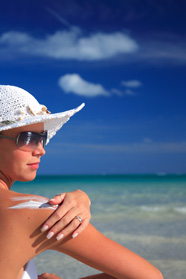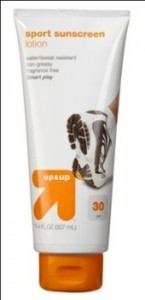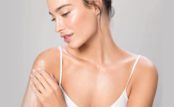 In your quest for the best anti-aging creams, new evidence suggests the secret to looking younger might have ‘SPF’ on the label. A good sunscreen can help folks look younger right through til middle age. This, as noted with an Australian study linking adults who regularly stathered sunscreen over four and a half years to 24% less skin-aging from the sun.The study is the first to back up a commonly spread mantra linking sunscreen use to younger skin, say the researchers. And it comes at a time of renewed interest in the quality of sunscreens to the consumer.A Consumer Reports study, released this month, lists the best and worst sunscreens. Their ‘best buy’ designation goes to Target’s Up and Up and Walmart’s Equate Ultra Protection. Five sunscreens made their ‘lowest-rated’ list, which we’ll cover, along with a basic sunscreen buyer’s guide and how to make a natural sunscreen.Notable too – the Environmental Working Group announced two weeks ago that Whole Foods has the best selection of ‘green’ sunblocks if you’re concerned about toxic ingredients in sunscreens.
In your quest for the best anti-aging creams, new evidence suggests the secret to looking younger might have ‘SPF’ on the label. A good sunscreen can help folks look younger right through til middle age. This, as noted with an Australian study linking adults who regularly stathered sunscreen over four and a half years to 24% less skin-aging from the sun.The study is the first to back up a commonly spread mantra linking sunscreen use to younger skin, say the researchers. And it comes at a time of renewed interest in the quality of sunscreens to the consumer.A Consumer Reports study, released this month, lists the best and worst sunscreens. Their ‘best buy’ designation goes to Target’s Up and Up and Walmart’s Equate Ultra Protection. Five sunscreens made their ‘lowest-rated’ list, which we’ll cover, along with a basic sunscreen buyer’s guide and how to make a natural sunscreen.Notable too – the Environmental Working Group announced two weeks ago that Whole Foods has the best selection of ‘green’ sunblocks if you’re concerned about toxic ingredients in sunscreens.
Study: Sunscreen Has Anti-Aging Benefits
The study, published in the June 4, 2013 issue of Annals of Internal Medicine, suggests that sunscreen’s anti-aging benefits remain from youth until middle age.Even if you’re a late arrival to slip slop slap, sunscreen appears to protect skin from sun-aging until at least the 50s, and perhaps longer. The key is to use it daily, with an SPF between 30 and 50, applied in a thick coating, and reapplied every two hours and/or after sweating or water exposure.For their methodology, researchers looked at data collected from a study on skin cancer protection between 1992-1996 in Nambour, Australia. They focussed on 903, mostly fair-skinned men and women under 55, assuming that skin-aging in this demographic would happen mostly from sun ‘photo-aging’ rather than simply getting older.Roughly half the subjects worked outdoors regularly. About four in ten were smokers.
The people with the least skin-aging applied it daily, with a thick, shot glass amount thoroughly, and re-applied often. That’s essential, say the researchers, who note sunscreen must be applied whenever folks sweat or get wet.
All the participants were randomly assigned to two sunscreen groups. Researchers directed the first group to use an SPF 15 sunscreen daily, on the head, neck, arms and hands, applied in the morning and re-applied after bathing, heavy sweating or spending a few hours in the sun.The second group used sunscreen when they wanted – but not as a requirement – and presumably less often as the first group.As well, the study assessed the potential impact of dietary supplements on skin quality. The researchers divided each group into half, with one subgroup taking 300mg of beta-carotene each day. The other took a sugar pill as a placebo.The team then analyzed skin damage with a process called ‘microtopography’, which analyzed skin changes in texture and roughness on each subject’s left hand. When the study ended, those who took a beta-carotene supplement did not have meaningful changes in skin aging. But after four and a half years, people who used sunscreen daily had much younger skin than people who didn’t slather each day, with 24% less skin aging in the daily sunscreen group compared to those who wore it when they chose.A few caveats with the study results. The researchers note the evidence applies to SPF 15. The people with the least skin-aging applied it daily, with a thick, shot glass amount thoroughly, and re-applied often. That’s essential, say the researchers, who note sunscreen must be applied whenever folks sweat or get wet.You’ll want to wear clothing over sunscreen too, and practice good summer skin care tips. Wear a wide-brimmed and sunglasses. And be sure to use a sunscreen – not a cosmetic cream with built-in SPF – because sunscreens last longer and offer stronger protection.
When the study ended, those who took a beta-carotene supplement did not have meaningful changes in skin aging. But after four and a half years, people who used sunscreen daily had much younger skin than people who didn’t slather each day, with 24% less skin aging in the daily sunscreen group compared to those who wore it when they chose.A few caveats with the study results. The researchers note the evidence applies to SPF 15. The people with the least skin-aging applied it daily, with a thick, shot glass amount thoroughly, and re-applied often. That’s essential, say the researchers, who note sunscreen must be applied whenever folks sweat or get wet.You’ll want to wear clothing over sunscreen too, and practice good summer skin care tips. Wear a wide-brimmed and sunglasses. And be sure to use a sunscreen – not a cosmetic cream with built-in SPF – because sunscreens last longer and offer stronger protection.
How the Sun Damages Skin
Ultraviolet radiation from the sun damage skin fibers called elastin. This causes the skin to sag and lose its ability to snap back when stretched.Sun damage can make skin bruise, tear more easily and take longer to heal. While it doesn’t show when you’re young, it will as you get older, often beginning in the 30s. Many dermatologists claim sun damage is the leading cause of wrinkles and visible aging.Sun damage can also lead to dark, ‘age spots’ because it stimulates overproduction of a pigment called melanin, and can lead to redness as blood vessels dilate permanently.Nothing will reverse skin damage completely, but sometimes the skin can heal itself. You might further avoid skin aging with some basic precautions. Try to avoid the sun, between 10AM and 4PM when possible and slather up when you can’t.Subjects in the Australian study wore an SPF 15 sunscreen, yet more doctors now recommend using a product with an SPF between 30 and 50. Below that might not give enough protection, yet products above SPF 50 fail to offer additional benefit.
Best and Worst Sunscreens 2014
The rules for sunscreen changed in 2012 when the FDA announced that all sunscreens with ‘Broad Spectrum’ designation must protect against both UVB and UVA radiation. SPF is just a measure of UVB protection – Broad Spectrum means it protects against both.Last month, Consumer Reports released its ranking of the best and worst sunscreen for 2014, based on their ability to do just that. Not all sunscreens are equal, according to their methodology, which found that just seven out of 23 made the cut.According to Consumer Reports, the recommended sunscreens are:
- Banana Boat Ultra Defense Max Skin Protect
- Bull Frog Water Armor Sport Instacool
- Neutrogena Ultimate Sport
- Well at Walgreens Sport
- Coppertone Water Babies
And the recommended and best buy goes to:
- Target’s Up and Up
- Walmart’s Equate Ultra Protection
At the other end, the five worst sunscreens were:
- Banana Boat Kids
- Beyond Coastal Natural
- Up & Up Kids
- Alba Botanic Very Emollient Sport
- Neutrogena Ultra Sheer Body Mist
Note this list is separate from the EWG’s list of best sunscreens, which ranks the products with fewest toxic ingredients rather than UVA and UVB protection.
 Sunscreen Buyer’s Guide
Sunscreen Buyer’s Guide
Experts point that sun damage can lead to skin cancer, which can be fatal. That means the best sunscreen is the one you’ll wear, and re-apply daily. Any sunscreen is better than none at all, and while the EWG contends that products with oxybenzone should be avoided, the alternative of not using sunscreen is no better and probably worse.The American Academy of Dermatology opposes the EWG’s claims, and says oxybenzone is safe.A few more things to consider the next time you buy sunscreen. SPF 15 blocks about 93% of UVB rays. SPF 30 gets 97% and SPF 50 blocks 98%. A product advertized as SPF 100+ blocks about 99% of UVB – not a huge difference from SPF 50 despite what you’d pay for products marketed as such.
- Buy a sunscreen between SPF 30 and 50
- Be sure it says ‘Broad Spectrum’ on the label
- Avoid products with oxybenzone if you like (but don’t stress too much about this)
- Opt for lotions rather than spray-on sunscreens for better coverage
Be sure to apply it often, preferably 20 minutes before sun exposure. Apply at least two ounces, which is roughly the size of a shot glass, and reapply every two hours, after water exposure or heavy sweating.
How to Make Your Own Sunscreen
Natural skin care purists might also like to make their own sunscreen. No argument here – you’re pretty much assured a toxin-free sunscreen that way. So experiment. Try sunscreen recipes of your own like this one courtesy of Wellness Mama.You’ll need:1/2 cup almond or olive oil (can add herbs as well)¼ cup coconut oil (natural SPF 4)¼ cup beeswax2 tablespoons zinc oxide (this has a natural SPF 20+ but take care not to inhale the powder)Optional – 1 teaspoon Vitamin E oilOptional – 2 tablespoons shea butter (natural SPF 4-5)Optional – Essential oils, vanilla extract or other natural extracts according to your tasteDirections:1 – Combine all the ingredients except zinc oxide in a pint-sized or larger glass jar. A pickle, olive or other large food jar should do the trick2 – Fill a medium sauce pan with about two inches of water and add medium heat3 – Put the jar in the water with the lid loosely sitting on top4 – Shake or stir the jar to help the contents melt. When they’ve melted completey, add the zinc oxide to the solution, stir in well, then add the solution to the jar you’ve chosen. Be aware this solution will not ‘pump’ in a pump-action bottle, which is why you’ll need a jar5 – Stir as it cools to incorporate the zinc oxide in the solution6 – That’s your sunscreen! Try to use within six monthsThis sunscreen should be water-resistant but not water-proof. The same rules are at work here – you’ll need to apply liberally and re-apply everytime you get wet. Also take care not to inhale the zinc oxide powder. Use a mask if necessary.This recipe has an SPF of roughly 20. Add more zinc oxide for stronger protection, and more beeswax for a thicker solution. Store in a cool, dry place like a pantry, or keep in your fridge.

 Sunscreen Buyer’s Guide
Sunscreen Buyer’s Guide


